 The Cambrian Fossils of Chengjiang, China
The Cambrian Fossils of Chengjiang, China
The first edition of The Cambrian fossils of Chengjiang was a ‘must have’ book for palaeontologists. Now I am afraid you are all going to have to fork out for the second edition. After 13 years, this completely revised edition reflects the significant amount of research that has taken place over the last decade or more on the remarkable Chengjiang lagerstätte.
The fossil material of the Chengjiang lagerstätte is of course stuff to drool over and the envy of palaeontologists who have to deal with the more common forms of hard-part preservation. Over 30 species have been added to the taxonomic list, reflecting a greater understanding of the diversity and taxonomy of this biota, which now boasts a total of over 250 species. A significant number of these are still ‘floating around’ waiting for their systematic identity card so the Chengjiang case is far from being closed.
The discovery is now over 30 years old, being first found in 1984 by Hou Xian-Guang, who is still active and one of the authors of this new edition. Since the first edition was published, the site has been inscribed on the UNESCO World Heritage List (in 2012) as a ‘globally outstanding example of a major stage in the history of life, representing a paleobiological window of great significance’. As such, the 515-520 Ma Chengjiang biota complements Canada’s slightly younger, 505 Ma Burgess Shale biota. The latter is somewhat less diverse (c 120 known species) but has a similar ecological structure; consequently, the taxonomic similarities and differences between the two are of particular evolutionary interest and significance.
This second edition of The Cambrian fossils of Chengjiang is much more than a mere update. It provides an overview of the lagerstätte and the rapidly expanding literature on all aspects of its geology, much of which is in Chinese and otherwise difficult to access. The format of the book is larger and many of the photos are even better than before. The book would be a fine present for any palaeontologist - even if you have to treat yourself!
Reviewed by: Douglas Palmer
THE CAMBRIAN FOSSILS OF CHENGJIANG, CHINA: THE FLOWERING OF EARLY ANIMAL LIFE. (2nd edn.) by HOU XIAN-GUANG et al. Wiley Blackwell. 2017. ISBN 978-1-118-89638-9. Hbk 316 pp. List price: £85.00 (hbk) £76.99 (e-book).
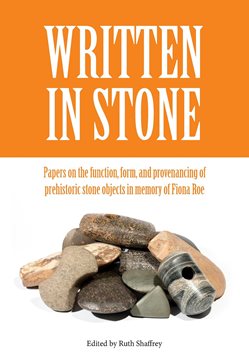 Written in Stone
Written in Stone
This book, ably edited by Dr Ruth Shaffrey, is a collection of 15 papers, together with a Dedication, Introduction, Bibliography (of the dedicatee), and Index, assembled to commemorate the life and work of Fiona Roe (née Greig), one of the most influential pioneers of the application of geological knowledge and methods to the understanding of stone objects from British archaeological sites. Her early, and perhaps most important, studies concerned the character and provenance of mainly Prehistoric axe-heads, battleaxes, mace-heads, adzes, and grindstones.
The emphasis in her later work lay on what are usually styled ‘items of worked stone’, including whetstones. Many of these very numerous, short contributions stemmed from financially constrained developer-led excavations that left little if any scope for detailed post-excavation analysis. There is consequently a certain tentative quality to these reports, with the occasional lithological attribution open to challenge.
The book has three parts: Implement Petrology and Typology; Prehistoric Querns: Form and Function; and Other Uses of Stone. There is good geographical balance in the topics examined. The first two parts will be of most interest to geologists of antiquarian persuasion. Anderson-Whymark and others write about Prehistoric mace heads in Orkney. Neolithic axe-heads of Cornish greenstone (dolerite/gabbro) and their groupings and distribution are the subject of a paper by Jones and colleagues.
Davis contributes (posthumously) a searching account of the provenance and distribution of axe-heads made from the very varied rocks of the Borrowdale Volcanic Group (central Cumbria), where around 600 production sites have so far been recognised. There is here enormous scope for further work. In Shetland, a local felsite has been exploited for a range of artefacts, as a study by Ballin with statistical support demonstrates. Another igneous rock, the dolerite of the Whin Sill, is prominent among axe-heads and battle-axes distributed over Yorkshire (Manby). As Fitzpatrick shows, the question of when lava querns from Germany began to appear in Britain remains contentious.
One or two pot-boilers aside, the papers are informative and interesting, of very good quality, and plentifully illustrated with photographs and drawings. Here and there, however, the production standards call for comment. Some photographs are too dark and others too small to be of much use. Some drawings have absurdly small lettering and others are ill-planned and too crowded. These problems were avoidable.
Written in Stone is a stimulating read and a worthy addition to the literature, from which geologists can learn much about how archaeologists currently approach items of stone. But the price, while perhaps not untoward, may be a deterrent.
Reviewed by John R L Allen
WRITTEN IN STONE - PAPERS ON THE FUNCTION, FORM AND PROVENANCING OF PREHISTORIC STONE OBJECTS IN MEMORY OF FIONA ROE by SHAFFREY, R (ed.), 2017, The Highfield Press, St. Andrews, i-xiv, pp. 356, ISBN 978-0-9926336-8-4-, List price: £50.00.
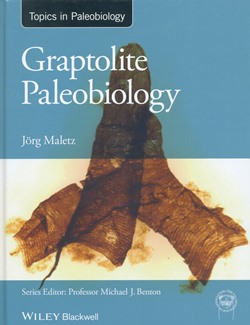 Graptolite Paleobiology
Graptolite Paleobiology
Graptolites might have lost some of their utilitarian appeal even to Palaeozoic biostratigraphers but they have gained in palaeobiological interest over the last few decades. Graptolite Paleobiology marks a useful point in graptolite studies when it is appropriate to take stock of what has been achieved.
Arguably the last time this happened was in 1955 when Bulman wrote the first edition of the graptolite volume of the Treatise. Maletz and contributors are to be congratulated on pulling together such a considerable body of research, stretching back nearly 300 years, and for producing such a beautifully illustrated and informative book, which deserves a place in every geological library.
It was 1735 when Linnaeus first noticed this somewhat enigmatic group of fossils. He coined the name Graptolithus, derived from the Greek via modern Latin and meaning 'written rock', although he thought that they were the fossil remains of plants.
Maletz reviews the progress that has been made, especially since the early decades of the 19th Century. At that time, graptolite studies were broadly divided between a European academic tradition with a biological approach to the fossils (especially in Sweden and subsequently Poland), whereas in Britain the approach was more utilitarian and biostratigraphical. Although there was of course a more general international interest in the taxonomy and evolution of the graptolites, this progressed quite independently of any need to understand their biological affinities. Conodont research had a similar history of development.
Only in the mid-20th Century did palaeobiological and biostratigraphical approaches begin to merge. As with that other group of enigmatic marine Palaeozoic fossils (conodonts), the underlying biological problem with graptolites was the zoological identity of the graptolite organism. Although microscope studies of chemically isolated specimens by Swedish palaeontologists had already presented clues as to the graptolites’ pterobranch affinity, it took another 70 years before the new technologies of scanning and transmission electron microscopy revealed the true connection.
Despite a diminishing number of researchers, great progress has been made across the whole range of graptolite studies in recent decades. Palaeobiology cannot stand alone without support from taxonomic and evolutionary research. As Maletz shows so clearly, all have benefited from the ability to examine chemically isolated specimens by electron microscopy both SEM and TEM. Crowther’s ‘breakthrough’ recognition in the late 1970s of the nature and origin of cortical ‘bandages’ in the structure of the graptolite stipe led the way.
Much of the graptolite research literature is notoriously scattered and often hard to access but Graptolite Paleobiology provides an excellent digest and is essential reading for all advanced students.
Reviewed by Douglas Palmer
GRAPTOLITE PALEOBIOLOGY by JÖRG MALETZ. Wiley Blackwell. 2017. ISBN 978-1-118-51561-7. 323pp. List price: £130.00 (hbk) £45.00 (sbk) e-book: £40.99 W: www.wiley.com/en-gb/Graptolite+Paleobiology-p-9781118515617
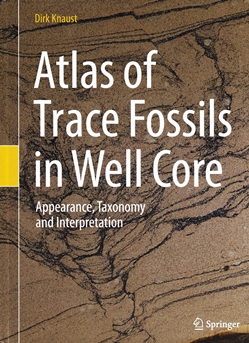 Atlas of Trace Fossils in Well Core
Atlas of Trace Fossils in Well Core
At the outset, your reviewer will reveal an embarrassing secret: despite logging cores for nearly 40 years, I have never felt assured in identifying trace fossils. I can pick out Skolithos and distinguish it from Chondrites and other key genera, and use them to diagnose environments and energy levels. But how about those other enigmatic markings, possibly of organic origin, but not falling into the half-dozen or so ichnogenera remembered from long-ago courses or well-thumbed manuals? Now, thanks to Dirk Knaust’s excellent textbook, I can face future ichno-questions with renewed confidence. I don’t think I shall be alone.
What makes this volume so attractive is the quality and variety of its photography. Each ichnogenus is figured in slabbed core with multiple images, with field photographs of ancient and modern environments, some including the creatures forming the traces. Bedding planes and vertical sections are shown, supported by sketches and other three-dimensional representations of the respective trace-fossil structures.
Marine forms dominate the atlas and there is little on freshwater or terrestrial trace fossils, although this reflects those most commonly found in core. The core photographs are mostly from the Mesozoic of the Norwegian continental shelf, so that carbonate environments have limited coverage, which will restrict the book’s usefulness within some basins.
Minor niggles: an atlas should be easily navigable, and this one isn’t. Some of the numerous illustrations are separate from the relevant text. Individual bibliographies for each section involve needless repetition. And the text diagram of ‘hierarchically arranged diagnostic criteria’ for identifying the ichnogenera described is valuable, but an ‘idiots’ guide’ conveying the same information in a series of thumbnail sketches, referring to page numbers of the detailed descriptions, would have been of immense assistance. Some advanced scholarship could have been sacrificed for the sake of ease-of-use.
The book is not aimed at researchers, who will already have Elsevier’s 2012 Developments in Sedimentology volume, and who await the forthcoming Treatise on Invertebrate Paleontology on the topic. Other trace-fossil guides for non-specialists exist, but most are course manuals or oil-company in-house compilations, often unavailable to the general reader. An exception is the SEPM Short Course No. 15 on Ichnology by Ekdale, Bromley and Pemberton, still available digitally, which though dated (1984) remains a valuable resource, especially for cash-strapped students. But it lacks the photography and recent advances of Knaust’s volume, which is likely to become the standard trace-fossil guide for postgraduates and professionals.
Review by Graham Blackbourn
ATLAS OF TRACE FOSSILS IN WELL CORE: APPEARANCE, TAXONOMY AND INTERPRETATION by DIRK KNAUST, 2017. Published by Springer Nature 214pp (hbk) ISBN: 978-3-319-49836-2 e-book ISBN: 978-3-319-49837-9 List price: £74.50 e-book £58.99. W: www.springer.com/gp/book/9783319498362.
.jpg?la=en) Risks, Rewards and Regulation of Unconventional Gas: A Global Perspective
Risks, Rewards and Regulation of Unconventional Gas: A Global Perspective
‘Unconventional gas’ - a hot term that evokes notorious images of flaming water taps in Pennsylvania - is a worldwide quest. Now, it is Poland’s turn to face all the possible trials and tribulations of extracting it from reluctant rock. Michael Labelle highlights (in Chapter 14 of this comprehensive, unreserved book) how in that country, once again, it is lack of governance, risk analysis and technology deployment that lie at the root of all problems.
Of course, it would be impossible to discuss the risks, rewards, successes and failures of unconventional gas without mentioning the country that currently leads the unconventional gas world – namely, the USA. Famous for their unquestionable success in exploiting and utilising shale gas (while unintentionally damaging the environment - a heavily publicised topic), the book resists repeating all this, and instead sensibly focuses its USA sections on political and economic issues - an aspect less often covered in more sensationalist accounts.
With the words ‘risk’ and ‘unconventional gas’ in the title, it is a tough book to review – and a brave one to let loose into a world full of judgement and critique but often short on facts and understanding. When opinions become so entrenched, factual science struggles to have any effect on people whose minds are made up and whose attitude to new sources of hydrocarbons is part of their identity. As John Adams puts it: “facts are stubborn things, but our minds are even more stubborn”.
This book fights against this tendency. It does not shy from controversy, but delivers an honest and sober view of the past, present and future of unconventional gas. It does not aim overtly to alter opinions but, steering clear of polemic, conveys an array of scientific, social, political and economic facts to help dispassionate readers weigh up the pros and cons for themselves.
Despite much political terminology, a text heavily laden with acronyms, and a slightly confusing layout, it is the ideal book for anyone wishing to develop an unbiased, factual understanding of the exploitation of unconventional gas globally. It takes a unique approach by comparing countries’ differing viewpoints on unconventional gas and their different regulatory regimes, providing an opportunity, perhaps, for countries to learn from one another’s mistakes – and successes.
It should prove a valuable text for governments, researchers and energy enthusiasts alike.
Reviewed by Olivia Milton-Thompson
RISKS, REWARDS AND REGULATION OF UNCONVENTIONAL GAS: A GLOBAL PERSPECTIVE edited by R QUENTIN GRAFTON, IAN G CRONSHAW AND MICHAL C MOORE, 2017. Published by: Cambridge University Press 494pp (hbk) ISBN: 9781107120082 List price: £71.99. W: https://doi.org/10.1017/9781316341209
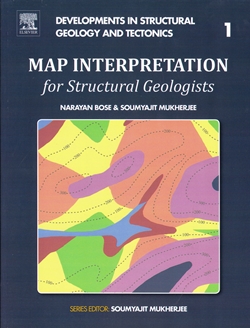 Map Interpretation for Structural Geologists
Map Interpretation for Structural Geologists
The concept of this short and simple book is to provide the autodidact student of geological maps with exercises in the use of strike lines, with a view to resolving exam-grade structural and engineering problems.
The ‘text’ is very brief, to the point, almost in minimalist note form. The black and white maps used are mostly extracts from earlier books of map construction, with superimposed coloured overlays showing how the strike lines and dips have been inferred. Thus the purpose is to provide worked examples, so that the student rehearses the skill of strike-line construction on increasingly complex problems, hence the need for the use of three-colour printing.
That would be all that needs to be said about this short and focused book, except that the pedagogy depends upon the following constraints; that the student has already read a good textbook on structural geology, is conversant with the technical jargon and has already worked through a foundation course on geological maps.
Its shortcomings are equally simple; because of the much-abbreviated explanations, the text is not developmental or even pleasing to read. Self-learners may even at times be left scratching their heads. One example on page nine shows a graphical derivation of true dip, with no explanation. The illustration appears on the face of it to be obvious, until we then see later examples in the rest of the book, which do not appear follow the same pattern of the illustration, leaving the student high and dry.
One further example is the frequent referral to solutions that have been inferred from ‘stereonet calculation’ without any further reference or back-up to assist the student further. This all lends a rather niggardly feel to the presentation which the authors probably assume is self-explanatory. However all the 40 examples are actually well-tried classics and they do work, so the basic information is there to be worked at.
In short, the treatment would suit an intermediate to advanced student preparing for a structural geology exam, or a working geologist who needs to refresh the method. However the price does imply that is was a short print-run and may therefore only be available only in specialist libraries.
Reviewed by Arthur Tingley
MAP INTERPRETATION FOR STRUCTURAL GEOLOGISTS by N BOSE and S MUKHERJEE 2017 Published by: Elsevier [paperback, pp120 ] ISBN 9780128096819 List price: £100.00 W: www.elsevier.com.
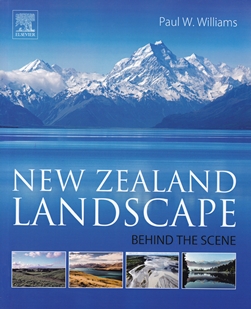 New Zealand Landscape: Behind the Scene
New Zealand Landscape: Behind the Scene
New Zealand’s landscape is like Scotland on acid: a young, exotic botanical garden atop a split twisted submerged continent spun off by Gondwana. I was captivated by an early visit, and have been back subsequently to marvel at the vividly active creation of this land. I wish I’d had this book back then: now I have it, I want to return more than ever.
Paul Williams is a Kiwi with a lifetime’s fascination for the tectonic and surface processes that have moulded the country he obviously loves. He is Emeritus Professor in the School of Environment, University of Auckland, and has a long-standing research interest in geomorphology. In writing this extremely comprehensive, clearly referenced and detailed book he seeks to explain, step by step, how the variety of picturesque scenes can be pieced together through evolution. He admirably sets out a vast, effortlessly clear chronology of geologic events, culminating in an assessment of the impacts and risks caused by humans intervening in an active, often hazardous, natural environment.
His educational talent has a helpful effect on the format. Like a military briefing, you’re told what you’re going to read, you read it, then you’re reminded what you just read. Each chapter starts with a short introduction that poses a central question. Williams takes us on a journey of investigation to amass and consider all the evidence, encompassing excellent diagrams, maps and breathtaking colour landscape and aerial photographs. A short conclusion followed by an extensive bibliography references each chapter.
It would be easy to highlight the riveting geologic issues of active volcanoes and earthquakes of New Zealand, but William’s tours de force are the impressive central chapters on the landscape development of New Zealand through immensely powerful water and glacial erosion to form a wide spectrum of types and features. We look at mass movement and the work of rivers, we consider the balance of rock removal and the counter process of uplift. Williams picks apart the ancestral history of river valleys to comprehend geologic formation. A noted specialist in karst hydrogeology, Williams lyrically explains the bizarre subterranean landscapes abounding in both North and South Islands. Glaciation and periglacial processes are richly evidenced and Williams unravels their effects alongside climate change.
This encyclopaedic book is a significant development in collating a richly detailed 4-D picture of New Zealand and an accessible knowledge bank upon which risk management can be considered to safeguard people’s future.
Reviewed by Jessica Cadzow-Collins
NEW ZEALAND LANDSCAPE: BEHIND THE SCENE by PAUL W WILLIAMS, 2017. Published by: Elsevier 470pp(pbk) ISBN: 978-0-12-812493-2 List Price: £118.00. W: www.elsevier.com/books/new-zealand-landscape.
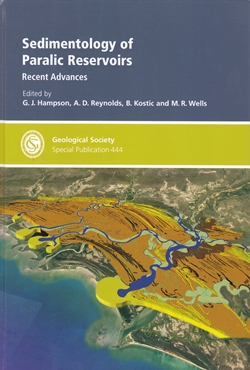 Sedimentology of Paralic Reservoirs: Recent Advances
Sedimentology of Paralic Reservoirs: Recent Advances
This is a good compilation of research offering a suite of analogues to aid the study of paralic reservoirs. It begins with an excellent overview by Reynolds, providing a helicopter-type perspective of reservoir architecture, recovery efficiency and stratigraphic and sedimentological description of paralic systems, with a subsurface uncertainty focus that can be used to better appraise and manage such reservoir systems. This forms the foundation of a suite of case-study-based papers from outcrop to subsurface, containing much detail that will be of value for benchmarking subsurface systems.
Most are largely descriptive works that provide insights and reference points for those studying analogous paralic systems. The excellent paper by Flood and Hampson on the Ness Formation in the Brent Field offers an interesting insight into the potentially predictive variability in sandbody architecture and controls of a floodplain system tied to accommodation space and location on the coastal plain.
Longhitano and Steel’s paper on controls on sandbody geometry and architecture in tidal seaways based on work from the Cretaceous in Wyoming and the Tertiary of the Calabrian arc, Italy provide an insight into stacking patterns and sandbody geometry in tectonically controlled tidal seaway systems. Gomis-Cartesio et al.’s work on the shelf edge delta systems from the Karoo in South Africa offers new observations on the shape, scale and geometry of slope channel systems and their potential predictability. This is another excellent contribution on these superbly exposed South African shelf, slope and basinal systems.
The other papers in this volume are all very good compilations of good quality, detailed research and analysis. Paralic reservoirs remain an important element of subsurface systems. With the increasing ability of numerical characterisations to include detailed subsurface description and better appreciation of how to assess and manage subsurface uncertainty and resulting risks the rich descriptions offered by this volume are of value to analogue and benchmark studies. This is a useful compilation with a diverse geographical spread that will doubtless be of value to future workers.
The content does not fully reflect the range of paralic depositional systems, being tidal/wave process dominated. I would also personally have liked to see more papers focused on field development and reservoir management versus exploration and appraisal, reflecting todays need to focus increasingly in recovery efficiency and production geology but this is I suspect a reflection of topics offered.
Reviewed by Mike Bowman
SEDIMENTOLOGY OF PARALIC RESERVOIRS: RECENT ADVANCES by G J HAMPSON, A D REYNOLDS, B KOSTIC AND M R WELLS (Eds) 2017. Geological Society of London Special publication SP444. 432pp, hbk. List Price: £120. Fellows’ Price: £60. Other Societies’ Price: £75. W: https://www.geolsoc.org.uk/SP444.